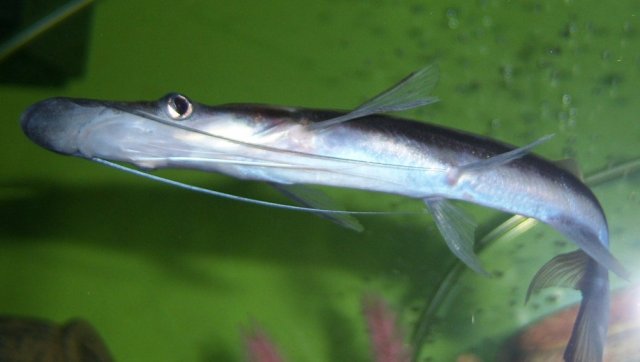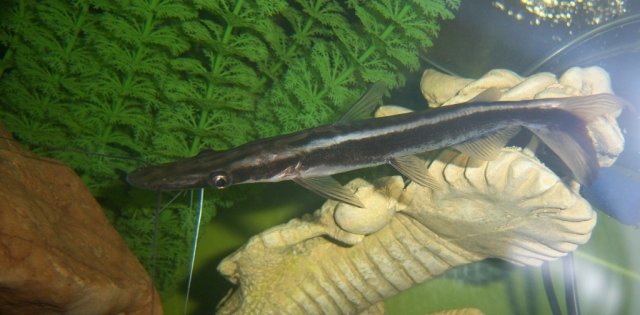Thanks to ColeFishing's push, I thought I'd put this together.
IME and IMO, the vast majority of people (in the US) thinking they are buying a Sorubim lima are actually buying a Sorubim elongatus. It appears far from trivial to tell one from the other using their exterior. Meanwhile, the adult size is quite different, 1' for elongatus and 2' for lima.
I still don't know what my old 7 were (never had a chance to grow them beyond 1') and neither do I know what my current 5 are (both do best and are spectacular in groups, especially when young; I'd recommend at least 7-10):




Here are some links for those who want to dig deeper into the ID issues:
Lima on PCF: http://www.planetcatfish.com/catelog/species.php?species_id=98
Elongatus on PCF: http://www.planetcatfish.com/catelog/species.php?species_id=697
From this review paper: http://www.mapress.com/zootaxa/2007f/zt01422p029.pdf .....
..... it would appear that the position of the mandibular barbels with respect to the gular apex is the ONLY way remotely feasible for a hobbyist to ID a live fish - find this key/algorithm in the revision, page 8:
Key to species of the pimelodid genus Sorubim
1 Gill rakers 31–37 (Fig. 1B)............................................... .................................................. ........S. maniradii
- Gill rakers 13–23 (Fig.1A, 1C)............................................... .................................................. ................... 2
2 Pectoral fin-rays 8; gill rakers on first arch modally 21; tooth patches on vomer not connected (Littmann
et al. 2001b, fig. 3b); insertion point of inner mental barbels even with or posterior to gular apex; head and
body elongate, body ovate in cross-section; eye diameter into interorbital distance 2–3 times; gape width
into head length more than 3.6 times............................................. .............................................S. elongatus
- Pectoral fin-rays 9, rarely 8 or 10; gill rakers on first arch 18 or fewer; tooth patches on vomer fused (Littmann
et al. 2000, figs. 4a and 4c,); insertion point of inner mental barbels anterior to gular apex; head and
body stout, body moderately compressed laterally; eye diameter into interorbital distance 3 times or more;
gape width into head length approximately 3................................................. ............................................. 3
3 Caudal fin with rounded lobes, distal caudal rays on upper and lower lobes curved (Fig. 2A); distributed
east of the Andes Cordillera .................................................. .................................................. .................... 4
- Caudal fin deeply forked and elongate, distal caudal rays on upper and lower lobes nearly straight and
pointed (Fig. 2B); restricted to the Lake Maracaibo, Sinu and Magdalena River basins.......S. cuspicaudus
4 Premaxillary tooth patch greatly exposed, exposed tooth patch length about equal to width (Fig. 3C); head
triangular and spear-shaped (Fig. 3B)............................................... ............................... S. trigonocephalus
- Premaxillary tooth patch moderately exposed, exposed tooth patch length contained 1.5 to 2.5 times in
width (Fig. 4); head oblong, not triangular........................................ ................................................. S. lima
http://www.planetcatfish.com/forum/viewtopic.php?f=13&t=30938&hilit=+lima - that's one of my original 7 lima/elongatus in the OP. As you could see, our colleague Back (high level hobbyist) from Finland thinks the position of the mandibular barbels with respect to the gular and other skull features may be telling, based on this paper.
http://www.monsterfishkeepers.com/f...1-SPECIES!!!&highlight=elongatus+lima+article
http://www.monsterfishkeepers.com/f...as-valid&highlight=elongatus+lima+differences
http://www.monsterfishkeepers.com/f...-thread-and-updates/page3&highlight=elongatus - page 3 especially
Colleagues from Europe, e.g., Netherlands, report seeing 2' limas often, which appears to be in a stark contrast with my (US) experience. This one gotta be a lima - close to 2': http://www.monsterfishkeepers.com/f...-catfish&highlight=elongatus+lima+differences - such photos are quite rare for some reason and no big ones on YouTube (http://www.monsterfishkeepers.com/f...Great-big-huge-lima-shovelnose&highlight=lima)
(http://www.monsterfishkeepers.com/f...Great-big-huge-lima-shovelnose&highlight=lima)
Anyone, feel free to add something of value or correct me if you catch my wrong(s).
Thanks.




...
Our first "lima", from back in 2010:


gular view and insertion of barbels:


IME and IMO, the vast majority of people (in the US) thinking they are buying a Sorubim lima are actually buying a Sorubim elongatus. It appears far from trivial to tell one from the other using their exterior. Meanwhile, the adult size is quite different, 1' for elongatus and 2' for lima.
I still don't know what my old 7 were (never had a chance to grow them beyond 1') and neither do I know what my current 5 are (both do best and are spectacular in groups, especially when young; I'd recommend at least 7-10):




Here are some links for those who want to dig deeper into the ID issues:
Lima on PCF: http://www.planetcatfish.com/catelog/species.php?species_id=98
Elongatus on PCF: http://www.planetcatfish.com/catelog/species.php?species_id=697
From this review paper: http://www.mapress.com/zootaxa/2007f/zt01422p029.pdf .....
..... it would appear that the position of the mandibular barbels with respect to the gular apex is the ONLY way remotely feasible for a hobbyist to ID a live fish - find this key/algorithm in the revision, page 8:
Key to species of the pimelodid genus Sorubim
1 Gill rakers 31–37 (Fig. 1B)............................................... .................................................. ........S. maniradii
- Gill rakers 13–23 (Fig.1A, 1C)............................................... .................................................. ................... 2
2 Pectoral fin-rays 8; gill rakers on first arch modally 21; tooth patches on vomer not connected (Littmann
et al. 2001b, fig. 3b); insertion point of inner mental barbels even with or posterior to gular apex; head and
body elongate, body ovate in cross-section; eye diameter into interorbital distance 2–3 times; gape width
into head length more than 3.6 times............................................. .............................................S. elongatus
- Pectoral fin-rays 9, rarely 8 or 10; gill rakers on first arch 18 or fewer; tooth patches on vomer fused (Littmann
et al. 2000, figs. 4a and 4c,); insertion point of inner mental barbels anterior to gular apex; head and
body stout, body moderately compressed laterally; eye diameter into interorbital distance 3 times or more;
gape width into head length approximately 3................................................. ............................................. 3
3 Caudal fin with rounded lobes, distal caudal rays on upper and lower lobes curved (Fig. 2A); distributed
east of the Andes Cordillera .................................................. .................................................. .................... 4
- Caudal fin deeply forked and elongate, distal caudal rays on upper and lower lobes nearly straight and
pointed (Fig. 2B); restricted to the Lake Maracaibo, Sinu and Magdalena River basins.......S. cuspicaudus
4 Premaxillary tooth patch greatly exposed, exposed tooth patch length about equal to width (Fig. 3C); head
triangular and spear-shaped (Fig. 3B)............................................... ............................... S. trigonocephalus
- Premaxillary tooth patch moderately exposed, exposed tooth patch length contained 1.5 to 2.5 times in
width (Fig. 4); head oblong, not triangular........................................ ................................................. S. lima
http://www.planetcatfish.com/forum/viewtopic.php?f=13&t=30938&hilit=+lima - that's one of my original 7 lima/elongatus in the OP. As you could see, our colleague Back (high level hobbyist) from Finland thinks the position of the mandibular barbels with respect to the gular and other skull features may be telling, based on this paper.
http://www.monsterfishkeepers.com/f...1-SPECIES!!!&highlight=elongatus+lima+article
http://www.monsterfishkeepers.com/f...as-valid&highlight=elongatus+lima+differences
http://www.monsterfishkeepers.com/f...-thread-and-updates/page3&highlight=elongatus - page 3 especially
Colleagues from Europe, e.g., Netherlands, report seeing 2' limas often, which appears to be in a stark contrast with my (US) experience. This one gotta be a lima - close to 2': http://www.monsterfishkeepers.com/f...-catfish&highlight=elongatus+lima+differences - such photos are quite rare for some reason and no big ones on YouTube
Anyone, feel free to add something of value or correct me if you catch my wrong(s).
Thanks.




...
Our first "lima", from back in 2010:


gular view and insertion of barbels:


Last edited:


